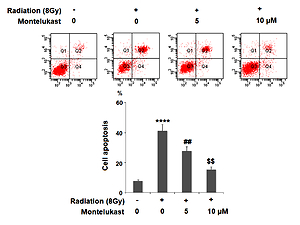Current issue
Archive
Manuscripts accepted
About the Journal
Editorial office
Editorial board
Section Editors
Abstracting and indexing
Subscription
Contact
Ethical standards and procedures
Most read articles
Instructions for authors
Article Processing Charge (APC)
Regulations of paying article processing charge (APC)
CARDIAC SURGERY / RESEARCH PAPER
Montelukast protects H9c2 cardiomyocytes against radiation-induced toxicity
1
Daliushu Campus of the Affiliated Hospital of Weifang Medical College, China
2
Affiliated Hospital of Weifang Medical College, China
Submission date: 2019-11-27
Final revision date: 2020-05-05
Acceptance date: 2020-05-22
Online publication date: 2021-04-13
KEYWORDS
TOPICS
ABSTRACT
Introduction:
Radiation-induced cardiotoxicity is a major concern following radiation treatment or involuntary radiation exposure. The normal functionality of cardiomyocytes becomes limited, which results in deleterious consequences, including an increase in the secretion of proinflammatory factors, such as HMGB1, and oxidative stress due to increased production of NOX4 and ROS. Radiation exposure results in disruption of the Bax/Bcl-2 ratio, increased expression of cytochrome c, and increased cleavage of caspase 3, thereby promoting cardiotoxicity and excessive apoptosis of cardiomyocytes. The cysLT1R antagonist montelukast is commonly used in the treatment of asthma, with recent studies showing potential for this drug in treating other diseases.
Material and methods:
Rat H9c2 cardiomyocytes were used in all the vitro experiments. The MTT assay was used to determined the The Cell viability; DCFH-DA staning was used to measure the intracellular ROS; and TMRM method was used to determine the level of ΔΨm in H9c2 cells; All mRNA levels of gene were measured by real time-PCR
Results:
In this study, we find that montelukast can mitigate the increase in oxidative stress and HMGB1 secretion induced by radiation, but also that montelukast exerts significant protective effects in terms of cell viability and apoptosis.
Conclusions:
The authors of the present work hope to aid in the elucidation of the role of montelukast as a pretreatment for radiation and find safe and effective solutions to this common side effect of such a prevalent treatment in today’s society.
Radiation-induced cardiotoxicity is a major concern following radiation treatment or involuntary radiation exposure. The normal functionality of cardiomyocytes becomes limited, which results in deleterious consequences, including an increase in the secretion of proinflammatory factors, such as HMGB1, and oxidative stress due to increased production of NOX4 and ROS. Radiation exposure results in disruption of the Bax/Bcl-2 ratio, increased expression of cytochrome c, and increased cleavage of caspase 3, thereby promoting cardiotoxicity and excessive apoptosis of cardiomyocytes. The cysLT1R antagonist montelukast is commonly used in the treatment of asthma, with recent studies showing potential for this drug in treating other diseases.
Material and methods:
Rat H9c2 cardiomyocytes were used in all the vitro experiments. The MTT assay was used to determined the The Cell viability; DCFH-DA staning was used to measure the intracellular ROS; and TMRM method was used to determine the level of ΔΨm in H9c2 cells; All mRNA levels of gene were measured by real time-PCR
Results:
In this study, we find that montelukast can mitigate the increase in oxidative stress and HMGB1 secretion induced by radiation, but also that montelukast exerts significant protective effects in terms of cell viability and apoptosis.
Conclusions:
The authors of the present work hope to aid in the elucidation of the role of montelukast as a pretreatment for radiation and find safe and effective solutions to this common side effect of such a prevalent treatment in today’s society.
Share
RELATED ARTICLE
We process personal data collected when visiting the website. The function of obtaining information about users and their behavior is carried out by voluntarily entered information in forms and saving cookies in end devices. Data, including cookies, are used to provide services, improve the user experience and to analyze the traffic in accordance with the Privacy policy. Data are also collected and processed by Google Analytics tool (more).
You can change cookies settings in your browser. Restricted use of cookies in the browser configuration may affect some functionalities of the website.
You can change cookies settings in your browser. Restricted use of cookies in the browser configuration may affect some functionalities of the website.



